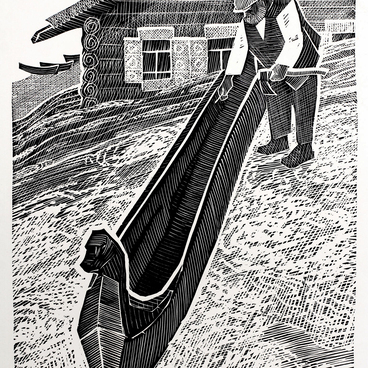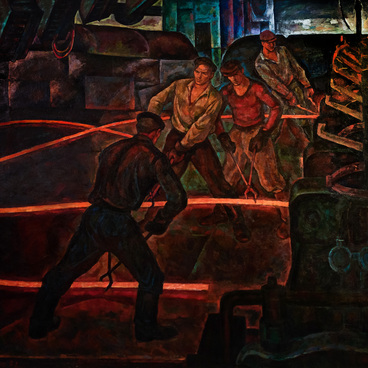The exhibition of the Irbit State Museum of Fine Arts features a lithograph “Apples” by Vladimir Mikhailovich Menshikov from his series “Collective Farm Market”.
In the center of the image, there is an energetic and friendly young woman. Acting in a flirtatiously playful manner, she fixes her disheveled hair into a ponytail while holding a hairpin between her teeth. “Menshikov’s collective farm market” is full of life and movement. Women wearing fancy headscarves and aprons smile at passersby. Shoppers bustle around the stalls. Anything can be found here, including fresh vegetables, fruits, meat, and fish. With exceptional skill, the artist captured everyday life at the market, conveying it through the poses, clothing, and household items. These graphic sheets are imbued with a warm-hearted atmosphere and a slightly nostalgic mood.
Vladimir Menshikov’s work was based on a thorough study of the legacy of classical drawing. He chose the line as his main means of expression, using it to convey form, movement, and silhouette. In this way, his approach is similar to that of the famous French impressionist artist Henri Matisse. For Vladimir Menshikov, each new artwork required extensive preparation. He created sketches from nature and genre scenes, gathering material for his life observations that were accurate, familiar, and sincere. Menshikov’s lithographs are wonderful illustrations of daily life. He captured the world of childhood, collective farm markets, and the lives of young workers and fishermen. His compositions were characterized by versatility, narrative lightness, and sincerity, reflecting the stylistic atmosphere of the 1970s. With his keen eye, the artist captured expressive scenes from the lives of ordinary citizens and village residents. An excellent draftsman, Vladimir Menshikov, used flowing lines to convey the figures and personalities of his characters.
Vladimir Menshikov represented the Leningrad school
of lithography. Among Soviet artists, lithography was one of the most popular
printmaking techniques, as it offered great freedom in solving the tasks
associated with plasticity and color.


